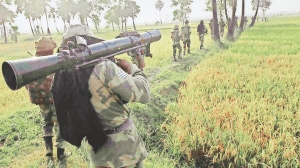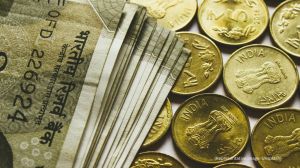Harikishan Sharma, Senior Assistant Editor at The Indian Express' National Bureau, specializes in reporting on governance, policy, and data. He covers the Prime Minister’s Office and pivotal central ministries, such as the Ministry of Agriculture & Farmers’ Welfare, Ministry of Cooperation, Ministry of Consumer Affairs, Food and Public Distribution, Ministry of Rural Development, and Ministry of Jal Shakti. His work primarily revolves around reporting and policy analysis. In addition to this, he authors a weekly column titled "STATE-ISTICALLY SPEAKING," which is prominently featured on The Indian Express website. In this column, he immerses readers in narratives deeply rooted in socio-economic, political, and electoral data, providing insightful perspectives on these critical aspects of governance and society. ... Read More
NFSA and PM’s promise of free foodgrains for five years: what it means and entails
At least 80 crore people will be benefited, and the BJP is likely to use the commitment to underline its welfare politics in the Lok Sabha election campaign. What is the Food Security Act, and what was the PM-GKAY? What are the cost implications? Here are some numbers.
 Seoni: Prime Minister Narendra Modi speaks during a public meeting ahead of the Madhya Pradesh Assembly elections, in Seoni, Sunday, November 5, 2023. (PTI Photo)
Seoni: Prime Minister Narendra Modi speaks during a public meeting ahead of the Madhya Pradesh Assembly elections, in Seoni, Sunday, November 5, 2023. (PTI Photo) Prime Minister Narendra Modi has announced the extension of the central government’s free foodgrains scheme under the National Food Security Act (NFSA), 2013 “for the next five years”. He made the announcement at election rallies in Madhya Pradesh and Chhattisgarh over the weekend.
The Pradhan Mantri Garib Kalyan Anna Yojana (PM-GKAY), the pandemic-time relief measure under which an additional 5 kg of foodgrains was supplied free to all beneficiaries of the NFSA from April 2020 onwards, was stopped with effect from January 1, 2023. However, the highly subsidised foodgrains being supplied under the NFSA were made free until the end of 2023.
The Prime Minister has now given a commitment that this free supply of grains will continue for another five years. It will benefit at least 80 crore people, and is likely to be used as a selling point by the BJP in its Lok Sabha election campaign. The PM had earlier mocked the “freebies” offered to voters by other parties as “revadi”.
देश में मेरा कोई भी परिवारजन भूखा न सोए, इसलिए 80 करोड़ गरीबों को मुफ्त राशन देने वाली योजना को भाजपा सरकार अब अगले पांच साल के लिए और बढ़ाएगी। pic.twitter.com/FAt9yhC85F
— Narendra Modi (@narendramodi) November 4, 2023
What was the PM-GKAY?
The PM-GKAY was launched in April 2020, as a Covid-19 pandemic hit, and economic activities came to a halt. Under the scheme, 5 kg of foodgrains were provided free to all beneficiaries of the NFSA. This relief was in addition to their entitlement of 5 kg of subsidised foodgrains under the law. (Details of NFSA in the answer to the next question.)
The scheme was started as one of the components of the government’s Rs 1.7 lakh crore Covid relief package announced by Finance Minister Nirmala Sitharaman on March 26, 2020, two days after the country went into a national lockdown.
The scheme was initially announced for three months — April, May, and June 2020. However, on July 8, 2020, it was extended for another five months, until November 2020. After the devastating second (Delta) wave of Covid hit in April 2021, the government restarted PM-GKAY, and approved a third phase of the scheme for May and June 2021.
Subsequently, the scheme was extended until November 2021. The second wave had ebbed by then, and a graded reopening was underway. But on November 24, 2021, the government announced a fifth phase of PM-GKAY — until the end of March 2022.
The decision was widely seen as a response to the coming Assembly elections in Uttar Pradesh and Punjab. The election results were declared in March 2022, but the government approved a sixth phase of the scheme — until September 2022.
Then, on September 28, 2022, as both the end of the scheme and the Assembly elections in Gujarat and Himachal Pradesh approached, the government announced phase 7 of PM-GKAY — until the end of December 2022. Finally, on December 24, 2022, the Cabinet announced the discontinuation of PM-GKAY, and the decision to give free foodgrains to eligible beneficiaries under NFSA for all of 2023.
And what is the NFSA?
The NFSA was enacted by the UPA-2 government, and came into effect on July 5, 2013. The law guaranteed “access to adequate quantity of quality food at affordable prices” under the Targeted Public Distribution System (TPDS) to 50% of the urban and 75% of the rural population of the country. The overall national coverage of the NFSA is about 67.5% of the population.
Under the law, the number of persons to be covered in rural and urban areas of a state shall be calculated on the basis of population estimates as per the Census of which the relevant figures have been published. The latest published Census figures are from 2011 — and based on that, about 81.35 crore people can be covered by the NFSA.
The subsidised prices are specified in Schedule-1 of the NFSA, which the government can change by executive order. Until the end of 2022, NFSA beneficiaries paid Rs 3, Rs 2, and Re 1 per kg of rice, wheat, and nutri-cereals (millets) respectively. These prices were not changed for years, even though the economic cost of foodgrains and the food subsidy bill grew steadily. From this year onwards, the rations were made entirely free.
The quantity of grains to which a beneficiary is entitled is also laid down in the law, and cannot be changed without Parliament’s approval.
There are two categories of beneficiary households under the NFSA — the Antyodaya Anna Yojana (AAY) households, and the Priority Households (PHs). Each AAY household is entitled to 35 kg of foodgrains every month irrespective of the number of members in the household.
PHs are entitled to receive foodgrains according to the number of family members. Each member of a PH is entitled to receive 5 kg of foodgrains every month under the NFSA. So, the bigger a PH family, the greater is the quantity of foodgrains it gets.
How much do these food security programmes cost?
The economic cost of foodgrains has four main components — pooled cost of grain, procurement incidentals, acquisition cost, and distribution cost. All of these have increased over the years. The economic cost of rice was Rs 2,615.51 per quintal in 2013-14, and had risen to Rs 3,670.04 in 2022-23. The economic cost of wheat rose from Rs 1,908.32 per quintal in 2013-14 to Rs 2,588.70 in 2022-23.
The government’s food subsidy bill too, has increased apace. It peaked at Rs 5,41,330.14 crore in 2020-21 before falling to Rs 2,86,469.11 crore in 2021-22. For 2022-23, the government budgeted a subsidy bill of Rs 2,06,831.09 crore, and said that the cost of distributing free foodgrains under the NFSA would be around Rs 2 lakh crore.
As of the beginning of this calendar year, the government’s expenditure on the PM-GKAY was about Rs 15,000 crore per month. The expenditure until the end of the seventh phase of the scheme was around Rs 3.91 lakh crore.
The government’s December 24, 2022 decision to provide foodgrains for free under NFSA was expected to put an additional financial burden of Rs 13,900 crore on the exchequer, and the total food security bill for the 2023 calendar year was estimated to be around Rs 2 lakh crore.
And how much money do NFSA beneficiaries save?
For Antyodaya Anna Yojana (AAY) families, who are entitled to 35 kg of foodgrains per month, the government had allocated 99.75 lakh tonnes (71.07 lakh tonnes rice and 28.68 lakh tonnes wheat) for the financial year 2022-23. This meant AAY families cumulatively were estimated to save a total Rs 2,705 crore for the entire year.
Similarly, for PHHs, the government allocated 423.86 lakh tonnes foodgrains (272.8 lakh tonnes rice, 144.76 lakh tonnes wheat, and 6.3 lakh tonnes nutri-cereals), enabling them to together save about Rs 11,142 crore in the year.
The NFSA is a rights-based scheme under a law of Parliament, while the PM-GKAY was a scheme announced by the executive as a top-up to the entitlements of beneficiaries covered under the NFSA.
Will the scheme of free rations benefit the BJP in elections?
The PM’s announcement came at election rallies, and were seen as being politically driven. While the states of Chhattisgarh, Madhya Pradesh, and Telangana, which are going to polls this month, already have several food security schemes for the poor, the announcement could send a signal for the coming Lok Sabha and other elections around the country, and amplify the BJP’s message of welfare politics.
The extension of PM-GKAY is believed to have helped the BJP in the state elections of UP and Uttarakhand. Subsequently, the BJP did very well in Gujarat as well, but lost in Himachal Pradesh. However, the Congress made its own welfare promises in the Himachal campaign.
The PM has criticised “freebies” offered by parties opposed to the BJP, but has himself handed out generous doles and presented himself as a messiah of the poor. According to BJP leaders, the party does not want to be seen as being opposed to the so-called “revadi”.
This is an edited and updated explainer based on two previous explainers that were first published on September 28, 2022 and January 3, 2023.



- 01
- 02
- 03
- 04
- 05




































